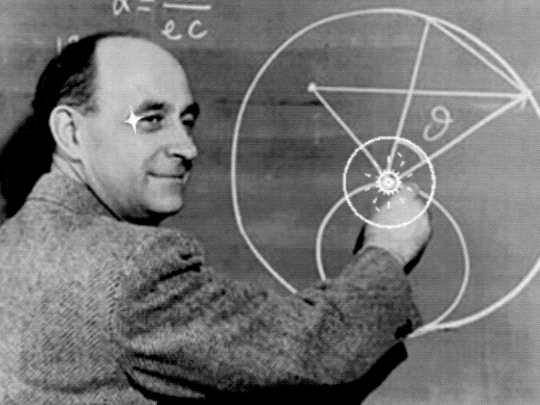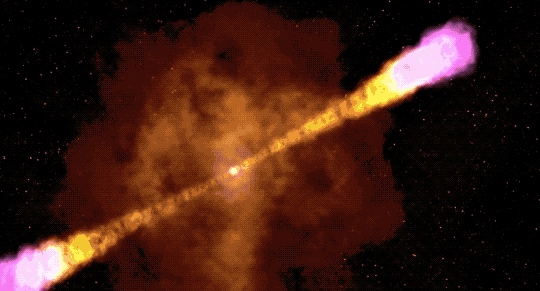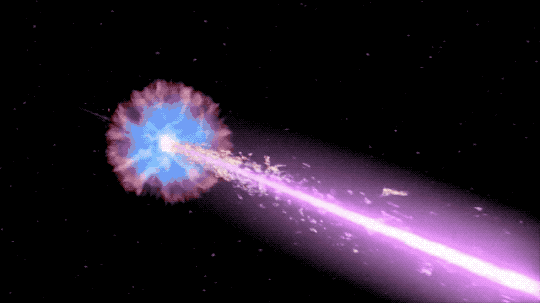The Fermi Gamma-ray Space Telescope is a satellite in low-Earth orbit that detects gamma rays from exotic objects like black holes, neutron stars and fast-moving jets of hot gas. For 11 years Fermi has seen some of the highest-energy bursts of light in the universe and is helping scientists understand where gamma rays come from.
Confused? Don’t be! We get a ton of questions about Fermi and figured we’d take a moment to answer a few of them here.
1. Who was this Fermi guy?
The Fermi telescope was named after Enrico Fermi in recognition of his work on how the tiny particles in space become accelerated by cosmic objects, which is crucial to understanding many of the objects that his namesake satellite studies.
Enrico Fermi was an Italian physicist and Nobel Prize winner (in 1938) who immigrated to the United States to be a professor of physics at Columbia University, later moving to the University of Chicago.

Original image courtesy Argonne National Laboratory
Over the course of his career, Fermi was involved in many scientific endeavors, including the Manhattan Project, quantum theory and nuclear and particle physics. He even engineered the first-ever atomic reactor in an abandoned squash court (squash is the older, English kind of racquetball) at the University of Chicago.
There are a number of other things named after Fermi, too: Fermilab, the Enrico Fermi Nuclear Generating Station, the Enrico Fermi Institute and more. (He’s kind of a big deal in the physics world.)

Fermi even had something to say about aliens! One day at lunch with his buddies, he wondered if extraterrestrial life existed outside our solar system, and if it did, why haven’t we seen it yet? His short conversation with friends sparked decades of research into this idea and has become known as the Fermi Paradox — given the vastness of the universe, there is a high probability that alien civilizations exist out there, so they should have visited us by now.
2. So, does the Fermi telescope look for extraterrestrial life?
No. Although both are named after Enrico Fermi, the Fermi telescope and the Fermi Paradox have nothing to do with one another.

Fermi does not look for aliens, extraterrestrial life or anything of the sort! If aliens were to come our way, Fermi would be no help in identifying them, and they might just slip right under Fermi’s nose. Unless, of course, those alien spacecraft were powered by processes that left behind traces of gamma rays.

Fermi detects gamma rays, the highest-energy form of light, which are often produced by events so far away the light can take billions of years to reach Earth. The satellite sees pulsars, active galaxies powered by supermassive black holes and the remnants of exploding stars. These are not your everyday stars, but the heavyweights of the universe.
3. Does the telescope shoot gamma rays?
No. Fermi DETECTS gamma rays using its two instruments, the Large Area Telescope (LAT) and the Gamma-ray Burst Monitor (GBM).
The LAT sees about one-fifth of the sky at a time and records gamma rays that are millions of times more energetic than visible light. The GBM detects lower-energy emissions, which has helped it identify more than 2,000 gamma-ray bursts – energetic explosions in galaxies extremely far away.

The highest-energy gamma ray from a gamma-ray burst was detected by Fermi’s LAT, and traveled 3.8 billion light-years to reach us from the constellation Leo.
4. Will gamma rays turn me into a superhero?
Nope. In movies and comic books, the hero has a tragic backstory and a brush with death, only to rise out of some radioactive accident stronger and more powerful than before. In reality, that much radiation would be lethal.

In fact, as a form of radiation, gamma rays are dangerous for living cells. If you were hit with a huge amount of gamma radiation, it could be deadly — it certainly wouldn’t be the beginning of your superhero career.
5. That sounds bad…does that mean if a gamma-ray burst hit Earth, it would wipe out the planet and destroy us all?
Thankfully, our lovely planet has an amazing protector from gamma radiation: an atmosphere. That is why the Fermi telescope is in orbit; it’s easier to detect gamma rays in space!

Gamma-ray bursts are so far away that they pose no threat to Earth. Fermi sees gamma-ray bursts because the flash of gamma rays they release briefly outshines their entire home galaxies, and can sometimes outshine everything in the gamma-ray sky.

If a habitable planet were too close to one of these explosions, it is possible that the jet emerging from the explosion could wipe out all life on that planet. However, the probability is extremely low that a gamma-ray burst would happen close enough to Earth to cause harm. These events tend to occur in very distant galaxies, so we’re well out of reach.

We hope that this has helped to clear up a few misconceptions about the Fermi Gamma-ray Space Telescope. It’s a fantastic satellite, studying the craziest extragalactic events and looking for clues to unravel the mysteries of our universe!
Now that you know the basics, you probably want to learn more!
Follow the Fermi Gamma-ray Space Telescope on Twitter (@NASAFermi) or Facebook (@nasafermi), and check out more awesome stuff on our Fermi webpage.
Make sure to follow us on Tumblr for your regular dose of space: http://nasa.tumblr.com.





Комментариев нет:
Отправить комментарий